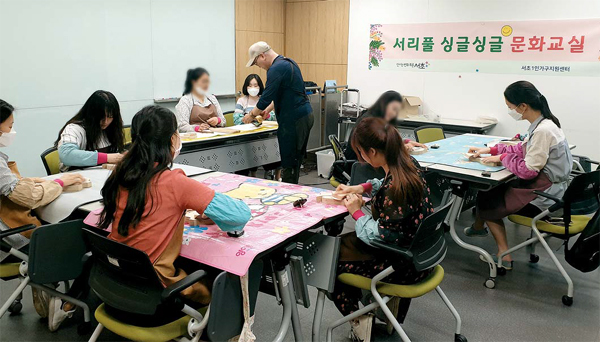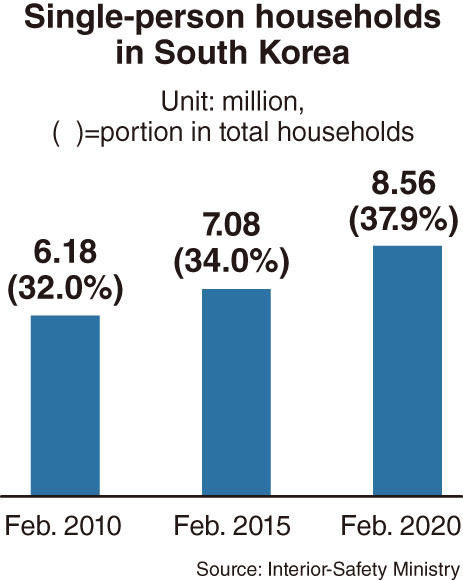 |
Seocho District in Seoul provides single-person household residents with a woodcraft class in June 2019, as part of its expansion in culture programs for those residing alone. But the regional administrative office, alongside most others nationwide, has halted all of its culture classes in the wake of COVID-19 since late January. (Seocho-gu Office) |
SEJONG -- South Korea saw the number of single-person households grow sharply over the past 10 years in the wake of continuously declining marriages, higher divorce rate and increasing number of senior population residing alone.
The number of single-person households came to 8.56 million out of the total, 22.56 million households, in the nation as of February, data from the Ministry of Interior and Safety showed.
They took up the largest percentage -- 37.9 percent (all-time high) of the total, which comprises two-member, three-member, four-member and other multiple-member households. The portion of those residing alone stayed at 34 percent in February 2015 and 32 percent in February 2010.
Seoul topped the list among the eight major cities with 40.7 percent -- 1.77 million among the total 4.34 million. This indicates that two out of every five households in the capital are composed of only one resident.
The capital posted a marked increase in the percentage of one-member households from 36.4 percent five years earlier and 35 percent a decade earlier.
When the two-member households (923,000 units) among Seoul citizens are included, six in 10 households, 62 percent, in the city were single- or two-member. In contrast, the portion of formerly typical four-member homes (690,000) stood at 15.5 percent of total Seoul households.
A demographic researcher said that residing alone is a trend not only among young and middle-aged Seoulites, but also elderly people.
 |
(Graphic by Kim Sun-young/The Korea Herald) |
Daejeon ranked second in the portion among the eight core cities at 37.9 percent, trailed by Busan (37.3 percent), Gwangju (36.6 percent), Daegu (34.9 percent) and Incheon (34.9 percent).
Among the nation’s nine provinces, South Jeolla Province recorded the highest portion of one-member households with 43.3 percent, followed by Gangwon Province (42.4 percent) and North Gyeongsang Province (41 percent). Theey we followed by South Chungcheong Province (40.9 percent) and Jeju (40.4 percent).
This shows that a growing number of seniors are residing alone in rural areas as they lost their spouse – particularly elderly women -- and their married children have moved to metropolitan cities.
In contrast, Gyeonggi Province ranked last among the nine provinces with 34.6 percent, that has new residential townships, where many newlyweds or two or three-member households moved to from Seoul.
When it comes to the 17 major areas, which comprise nine provinces as well as the eight cities, Sejong and Ulsan ranked last and second-last with 32.1 percent and 32.3 percent, respectively.
Sejong and Ulsan have the lowest percentage of seniors – aged 65 or over -- in the nation, as they hold administrative- and manufacturing--oriented jobs, respectively.
“The trend toward more single-person households is spreading rapidly across major cities and rural areas,” said a government official. “Among the factors are low fertility rates, rising divorce rates, falling marriages and the movement of young people born in rural districts to urban areas.”
Ten years earlier, in February 2010, four-member households accounted for 21.9 percent -- 4.23 million of the total 19.31 million households nationwide.
It was the second-greatest by proportion, trailing single-person households whose number and percentage out of the total households posted 6.18 million and 32 percent, respectively. The third- and fourth-largest were two-member (19.1 percent) and three-member (18.7 percent) households a decade earlier.
In contrast, in February 2020, the proportion of four-member households stayed at 16 percent, while the two-member and three-member households ranked second and third, at 22.9 percent and 17.7 percent, respectively.
Korea’s fertility rate fell to a fresh record-low of 0.85 children per woman as of the fourth quarter of 2019. The number of marriages posted 65,769 during the October-December period, down 8 percent over the same period a year earlier.
By Kim Yon-se (
kys@heraldcorp.com)









